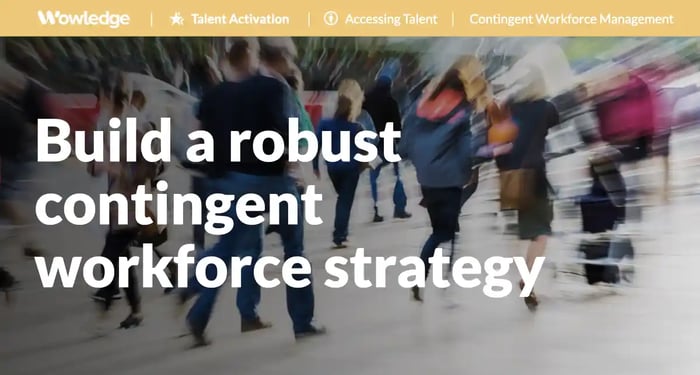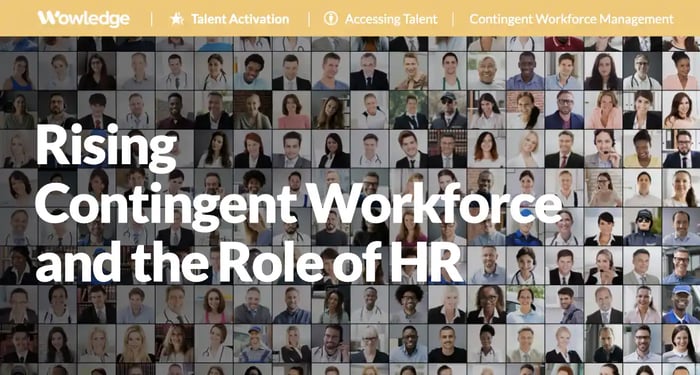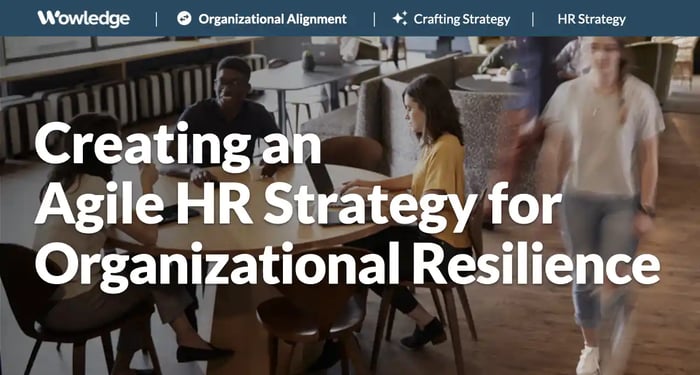Table of Contents
- Defining the concept
- The rising prevalence and use of contingent workers
- Developing a contingent workforce strategy
- 1. Understand/clarify business plans and objectives
- 2. Determine the governance structure
- 3. Conduct a skills analysis
- 4. Assess talent availability by region
- 5. Source and recruit talent
- 6. Onboard and integrate contingent workers
- 7. Identify and develop a technology infrastructure
- 8. Manage legal and compliance considerations
- 9. Standardize performance management
- 10. Communicate and collaborate
- 11. Practice sound financial management
- 12. Mitigate risk
- 13. Address the contingent worker experience
- 14. Measure to manage continuous improvement
- Building a network of contingent resources
- Relevant Practices & Tools
- FAQs
-
The makeup of the modern workforce has changed significantly from a decade ago. While utilizing contingent workers is not new, it has emerged as a critical strategy for businesses navigating the dynamic currents of the labor market. The paradigm shift towards a more flexible, adaptable approach to talent acquisition has created a diverse pool of professionals, including freelancers, contractors, temporary workers, and gig workers. As the importance of incorporating contingent workers as a strategy rises in response to talent shortages and increased employee turnover, it is imperative to understand their growing role in the United States labor market. Building a contingent workforce strategy has become essential for HR teams.
The role of contingent workers has moved beyond temporary or seasonal fill-ins, now offering a unique blend of specialized skills and on-demand availability at an unprecedented scale. The trend is not merely a temporary phenomenon but a transformative force shaping the future of work. Statistics reveal a significant surge in the number of individuals choosing alternative work arrangements, fostering a gig economy and reshaping traditional employment norms. This evolution is not only a response to the changing aspirations of the workforce but also a strategic move by businesses seeking to enhance their operational agility. Companies increasingly recognize the need to harness the diverse talents among such workers, establishing contingent workforce management processes that integrate them seamlessly into their structures to bolster innovation and efficiency.
In exploring the contingent workforce landscape, the key is understanding their increasing prevalence, how businesses can access their skills and capabilities, and how to build a comprehensive strategy. From project-based collaborations to specialized individual expertise, the avenues for using such talent are vast, providing organizations with unprecedented flexibility in meeting their staffing needs. This will include developing strategies for sourcing contingent workers and examining the platforms, networks, and methodologies that facilitate seamless integration of these professionals into the workforce. Furthermore, the key steps for establishing a robust contingent workforce strategy will be outlined, offering insights into how HR and counterpart functions can expand their talent acquisition processes to thrive in a rapidly changing employment ecosystem.
Defining the concept
Contingent workers are those brought in for well-defined, short-term assignments to help fulfill business requirements that organizations cannot meet with current staff. These are typically due to a lack of suitably skilled staff members or an insufficient supply or number of employees to conduct the Such workers are known by a wide range of terms, including contractor, consultant, temp, freelancer, or on-call worker. They may be self-employed or employed through a traditional temporary or specialized outsourced labor provider, the latter of which is commonly used to supply skilled technology-related workers. work in the desired location and timeframe necessary.
Core to understanding this is how they contrast with those called “employees”—their work relationship is not considered “permanent,” they are not paid ongoing salaries, and they lack access to welfare, retirement, and paid time off benefits. They, most importantly, are not typically taxed, and the employer-matched employment and related taxes are paid and withholdings are made on their behalf; as such, they are not treated the same as “regular” employees. As a result, and/or related to such treatment, they are not afforded the same protections under U.S. laws as their employee counterparts. Furthermore, organizations do not generally include them in company events, skill and career development activities, and other benefits meant to engage and embrace employees into the culture.
The strategy of employing such workers is alternatively known as supplemental staffing, staff augmentation, agile staffing, process/task/project outsourcing, or subcontracting. Other related terms, such as offshoring and onshoring, relate to outsourcing or insourcing work processes to other locations that generally involve lower cost profiles for the organization. A contingent workforce strategy is designed to address staffing needs that regular employees cannot meet on their own.
The rising prevalence and use of contingent workers
The value of using alternate sources of expertise is becoming increasingly important, as it provides added workforce capacity for large-scale strategic initiatives (e.g., business transformations, new product and service development or implementations), increased revenue-generating efforts (e.g., seasonal sales push, new market openings), or for resolving or bridging skills gaps (critical skill project staffing, strategic project implementation and management).
Additionally, and critically, it provides tremendous value by mitigating two primary factors driving skill availability challenges worldwide—skills obsolescence and chronic labor shortages. For example, according to ongoing research by the World Economic Forum, in 2023, the share of workers’ skills that are projected to be disrupted in the following five years has risen to 44%, with those most prominent being reported as including analytical thinking, creative thinking, AI and Big Data, and leadership and social influence. The rapid spread of artificial intelligence (AI) and related technologies, increased adoption of robotics, industry downturns, and work-process improvements driven by automation efforts and greater efficiencies that lead to fewer workers are driving the surge in the need for employee upskilling.
The trend has been identified in projections by the U.S. Government Accountability Office (GAO), which estimates that 50 percent of the U.S. workforce will be freelance or contingent workers by 2050. Clearly, a contingent workforce strategy is needed.
Understanding the true percentage of the total US working population engaged in contingent work is complex, as many people participate in the gig economy as secondary employment. In fact, the US Bureau of Labor Statistics (BLS) recently issued a request for public comment on the questions it asks in the “Contingent Work Supplement” (CWS) of the Current Population Survey, released earlier this year. The request concerns the necessity, value, and accuracy of the proposed data. Nonetheless, its most recent estimates are that about 16-17% of American workers were either independent contractors or temporarily employed. Statista estimates are much higher, projecting the number at 59M (36% of the total workforce) this year, with steady growth to 90.1M in 2028. It predicts that over the next few years, that number will increase to 86.5 million freelance workers (50.9 percent of the total U.S. workforce).
However, it also notes that the average gig worker puts in only 11-30 hours per week in this type of work, suggesting that a mix of full-time and part-time roles will continue. Such an insight is bolstered by data from Pew Research, which suggests that only 31% of those working through digital platforms (Uber, DoorDash, Upwork, etc.) work full-time.
However, the prevalence of contingent workers continues to grow. For example, McKinsey found that 36% of the American workforce was self-employed in 2022, while ADP reported that in 40% of companies, its payroll data found that one in four (1/4) employees is a gig or part-time worker. Furthermore, the Government Accountability Office (GAO) estimates that 89% of S&P 500 companies use contracted workers as a regular part of their staffing solutions.

Developing a contingent workforce strategy
Developing an outsourced or contingent workforce strategy to address gaps in critical skills and general talent shortages requires careful consideration of various factors. It requires the same due diligence that accompanies any business strategy—clarifying business objectives, plans, and goals; assessing related talent requirements; identifying gaps to be filled; determining the best sources for the needed talent; bolstering hiring and employment processes to meet greater volumes; and installing a continuous evaluation process. Key steps include:
1. Understand/clarify business plans and objectives
Research and reflect on the specific business plans, goals, and outcomes to be achieved during the planning period. Pay close attention to the new products, services, locations, technologies, and capabilities to be developed and deployed in the coming years. Through this, the required human capabilities can be identified.
2. Determine the governance structure
Ownership and responsibility for the entire lifecycle of contingent worker employment must be clearly defined to avoid overlapping requirements and management confusion. The roles of purchasing or procurement, hiring managers, and HR require clarification, especially as contract labor becomes an increasingly high percentage of the workforce. As HR can provide unique planning and insights into the total labor force with strategic workforce planning (SWP), staffing requirements (via talent acquisition processes), and skills gaps, its role will continue to evolve and increase in potential for impact. At the same time, purchasing functions have well-established expertise in outsourcing and subcontracting policies, processes, technologies, finances, and external networks, which are essential elements to build upon. Shared governance with clear lines of responsibility should be included in any strategy.
3. Conduct a skills analysis
Identify the skills and expertise required for new, expanded, or different enterprise capabilities, projects, or tasks. Either relying upon that listing alone or an enterprise skills library that has been created and/or updated, conduct a comprehensive skills assessment with the current employee base to identify the specific expertise gaps within the organization. Leverage a survey method asking targeted employees to complete a self-assessment and have their managers validate/edit those. Consider which of these skills will be critical strategic capabilities that ultimately need to reside in-house versus those that can be safely and readily outsourced or assigned to short-term workers.
4. Assess talent availability by region
Research geographic locations where the needed skills/professions tend to be located, including the availability in or near existing organizational locations. This will assist in determining the strategies to be employed to source the necessary skills. Low availability in the immediate area might create an awareness of the need to engage with outsourced labor companies, whereas higher availability might push one towards direct employment options. Starting with the U.S. Bureau of Labor Statistics (BLS) and Census Bureau’s data, expanded searches can be accessed through paid services and platforms such as those provided by Lightcast, WorkforceGPS (Labor Market Information), Chmura Economics and Analytics, etc.
This step can also inform decisions about fully outsourcing the work, hiring gig workers to augment and integrate with existing staff, and whether to offshore or onshore the work based on talent availability and access.
5. Source and recruit talent
Establish a robust process for sourcing and recruiting freelancers, contractors, and gig workers. This may involve using specialized platforms, working with staffing agencies, or building a talent pool through networking. Engage reputable and reliable providers or agencies that specialize in the type (and volumes) of talent needed to augment the existing employee base. Companies should evaluate potential outsourcing partners based on their expertise, reputation, and ability to meet specific skill requirements. The cultural fit and alignment of values between the organization and outsourcing partners are also crucial to ensure effective collaboration.
6. Onboard and integrate contingent workers
Develop a comprehensive onboarding process to integrate temporary workers seamlessly into the organization, emphasizing core workplace values, behavioral standards, and expectations. Policies, practices, and checklists should be provided that outline facility access, break time and location, security and data protection standards, and the use of equipment, facilities, and resources. Such workers should be introduced to project or initiative team members and have their specific roles, responsibilities, and deliverables formally documented and shared.
7. Identify and develop a technology infrastructure
Ensure the organization has the necessary technology infrastructure to support necessary work and pay-related records collection and storage, project management toolsets, and remote work and collaboration platforms for hybrid workforce effort integration. This includes communication tools, project management platforms, and security measures for protecting sensitive information. The most basic technology for the administration of these workers is a vendor management system (VMS), which can include legally required identifications (SSN, Green Card, passport number, home address, etc.), project assignments, source (including the subcontracting company), skills listing/assessments, role performance data, availability timeframes, etc.
8. Manage legal and compliance considerations
Understand and comply with legal and regulatory requirements related to temporary and freelance work. Clearly define the legal status, rights, and responsibilities of such workers, and ensure contracts are well-drafted, comprehensive, and compliant with relevant laws and regulations. Proof of the right to work in the U.S. is an essential consideration here.
9. Standardize performance management
Implement performance management processes for temporary workers, including regular feedback and evaluations, typically delivered by the assigned line manager. Clearly communicate expectations and key performance indicators. Devise standard approaches, timeframes, and cadences for feedback and correction/decision-making related to continued employment. Establishing clear communication channels, setting performance metrics, and implementing robust project management practices with both the worker and the subcontractor (if applicable) are vital to successful collaboration.
10. Communicate and collaborate
Foster effective communication and collaboration between in-house teams and temporary workers. Utilize collaboration tools and establish channels for regular updates and information sharing unique to these workflow-related (vs. social or engagement) collaborations to avoid any assumption of equivalent status with employees.
11. Practice sound financial management
Develop a budget and decision-making model for contingent labor that delivers overall labor cost savings for the organization. Establish a transparent and fair compensation structure for temporary workers, either directly with them as individuals or through the subcontracting or temporary employment agency. Consider skill-based hourly rates, project-based payments, and any additional benefits or bonuses that might motivate outstanding performance while ultimately driving labor savings to the organization. Plan on rate mark-ups for those hired through agencies.
12. Mitigate risk
Identify and mitigate risks associated with the use of temporary workers, including data security, intellectual property protection, and potential disruptions to project timelines. Separate data collection, management, and storage from that of regular employees. Create clear barriers to standard employee processes and benefits, particularly those related to social, development, and/or morale events that extend beyond the immediate project team.
13. Address the contingent worker experience
Within the context of keeping the treatment of employees from contractors separate to avoid labor-law-related claims, build consideration for the overall experience of temporary workers into the strategy. Design elements into the contingent worker hiring, employment, and management processes that provide a positive, inclusive experience, which can lead to better productivity and a positive reputation in the gig economy.
14. Measure to manage continuous improvement
Regularly assess and refine the augmented workforce strategy based on feedback, performance metrics, and changes in business needs. Strive to remain agile and adaptable to industry trends and advancements. Assess each vendor's quality, timeliness, reliability, and delivery/quality. Regular reviews and flexibility in the outsourcing strategy are also key to adapting to evolving business needs and ensuring ongoing success in talent augmentation.

Building a network of contingent resources
Identifying reliable sources of individuals and companies capable of filling critical staffing needs is a core element of building an ecosystem for continuous contingent worker resourcing. Determining where to source needed labor should be conducted in conjunction with the procurement or purchasing function. As those tend to have specialized experience, tools and resources, and networks for supplying “purchased” or contingent labor, they can generally be relied upon as the primary source for such relationships. It is essential to understand the role of such a function, with specialized expertise and established processes related to sourcing, evaluating bids, contract negotiations and rate setting, payments, and collecting managerial feedback. Coordination with that function is an essential element of sustainable success and a key component of the contingent workforce strategy.
However, such expertise can now be augmented by widely available, user-friendly internet platforms and websites that provide access to an open marketplace for expertise. In general, freelancers, gig workers, contract workers, and temporary workers often use a variety of online platforms and resources to find work opportunities. These are often used in conjunction with standard networking, marketing, and direct sales approaches by both individual practitioners and agencies or companies that specialize in providing temporary or contract labor to companies in need. There are a variety of sources, listed with top examples, including:
Freelance Platforms:
• Upwork: A large platform that connects freelancers with clients looking for various skills.
• Freelancer: Similar to Upwork, it offers a range of freelance jobs.
• Fiverr: A platform where freelancers offer services starting at $5.
Industry-Specific Platforms:
• GitHub: Developers can find freelance gigs or contribute to open-source projects.
• Dribbble: Designers showcase their work and may find freelance opportunities.
• Gigster: Technology-related project work matching site.
Specialized Freelance Websites:
• Toptal: Connects freelancers with top clients in software development/design and finance.
• 99designs: Specifically for freelance designers.
• WriterAccess: Connects freelance writers with clients.
• Hirable: Freelance software developers.
Networking Platforms:
• LinkedIn: Professionals can find freelance opportunities through networking.
• Twitter: Some freelancers use Twitter to promote their services and connect with clients.
Temp Agencies and Specialized Recruitment Agencies:
• Robert Half, Aerotek, Adecco Staffing: Traditional temp agencies connect individuals with short-term employment opportunities, including professional, technical, and manual labor categories.
• SeasonalJobs.dol.gov, GovTempsUSA: providers of temporaries for federal, state, and local governments.
As part of the contingent workforce strategy, it is also recommended that company recruiters and managers alike remain open and active in identifying potential workers while attending industry and association conferences and meetings, as professional networking remains an excellent source of talent, both regular and contingent. Similarly, leveraging traditional job boards and social media sites to promote and find temporary expertise should be considered a viable option to augment other efforts.
Relevant Practices & Tools
Emerging HR Strategy Practices for Engaging Employees and External Partners Now and Into the Future. >
At its most sophisticated level, HR Strategy defines a future centered around optimizing how employees and their needs are managed and how critical external resources... more »
Incorporating Non-employees into Future Planning for More Robust Staffing Strategies. >
Contingent workers, consultants, contractors, freelancers, and "gig" workers are terms used to describe individuals external to the organization... more »
Building "Future of Work" Considerations into Workforce Planning. >
The "Future of Work" is a construct that is based on three major components - forthcoming changes in work method ("what" is done), the makeup of the worker population... more »
Leveraging Outsourcing for Cost-effective Services and Solutions. >
A key element of planning HR strategies involves the decision to build internal capabilities vs. outsource those to a partner organization... more »
The Talent Gap Analysis Goal ID Tool: Capture Critical Role Staffing Challenges and “6Bs” Strategic Talent Management Responses. >
This tool incorporates the multi-source staffing strategy outlined by Dave Ulrich and others that references the “Buy, Build, Borrow, Bind, Bot, and Bounce” options... more »
FAQs
What governance model works best to manage a large contingent workforce program?
Effective programs use shared governance between HR, Procurement, Legal, Finance, Security, and business leaders with a single executive owner accountable for outcomes. A steering committee sets policy, risk thresholds, and funding, while an operational council manages suppliers, exceptions, and continuous improvement. Clear RACI and service levels should be defined and documented for requisitioning, onboarding, access, and offboarding to prevent gaps and co-employment risks.
What are the critical legal and compliance risks to address up front?
Misclassification and co-employment are the primary risks, where strict rules must be followed to avoid claims that contractors are de facto employees and thus are due pay, benefits, and employment law protections. Programs should codify as company policy the tests used by relevant jurisdictions, standardize engagement terms, and log exception decisions with legal review. Periodic audits of assignments, hours, and managerial control help demonstrate good-faith compliance. Always consult employment law experts when engaging individual contractors of temporary labor providers.
What onboarding and offboarding practices reduce risk without slowing delivery?
Provide a streamlined path focused on identity verification, confidentiality, and intellectual property (IP) agreements, access provisioning and control, and safety or privacy training specific to the assignment. Time-box access to data, facilities, and equipment for the project duration, enforce equipment return attestations, and automate immediate deprovisioning and system/facilities accesses on assignment end. Standard checklists with manager sign-off minimize orphaned accounts and knowledge loss.
How should performance be measured for contingent workers and suppliers?
Hold the contracting organization responsible for managing the performance of their labor, and be specific in writing the expectations for task performance, work product quality, timeliness, and behavioral standards. Measure delivery outcomes, rework rates, security or compliance incidents, and stakeholder satisfaction at the assignment level. Roll up supplier scorecards that include fill speed, compliance with task and behavioral delivery standards, quality during the first 90 days, diversity contribution, and invoice accuracy. Tie preferred status and future demand allocation to sustained performance rather than negotiated rate alone.










